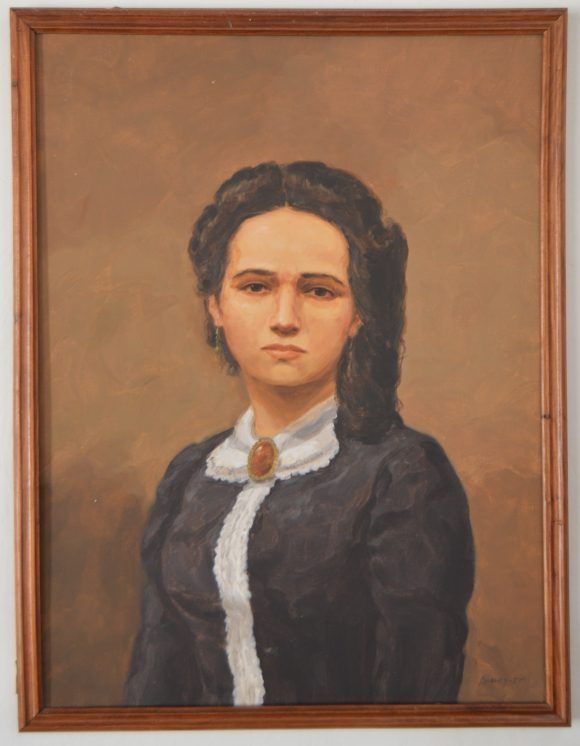
Candelaria Figueredo. A young woman from Bayamo who, on October 20, 1868, when the enemy garrison capitulated, dressed as an Amazon, with a Phrygian cap, and carried the flag through her hometown, being victorious as she passed. She has since gained the beautiful title of "La Abanderada".
She was born on February 2, 1852, the daughter of the wealthy lawyer and landowner Pedro Figueredo Cisneros (Perucho) and Doña Isabel Antonia Vázquez Moreno. Her childhood was calm and happy in her hometown, as her father was not in favor of sending her daughters to study abroad. She grew up hearing expressions of hatred for foreign oppression, because Perucho could never bear the yoke of slavery even in the midst of comfort.
Revolutionary work
During the conspiracy process of 1868, Canducha Figueredo supported each of the actions of her beloved father. On August 14, 1867, when the Revolutionary Committee of Bayamo was created in her house, to prevent discussions from being heard in the street, she and her sister Eulalia played the piano. As the conspiracy progressed, Perucho's daughters gathered medicines at the Las Mangas mill, until on October 17, 1868, she received the commission from her father to make a flag similar to the one raised by Carlos Manuel de Céspedes in La Demajagua. In this way, she became the standard-bearer of the La Bayamesa Division.
On the 18th at seven in the morning, the insurgent contingent left Las Mangas, along the Santa Ana road to lay siege to the Spanish Infantry Barracks inside the city of Bayamo, while Generalissimo Céspedes attacked other colonialist positions. The siege lasted until October 20, when the enemy garrison capitulated. Then Candelaria Figueredo dressed as an Amazon, with a Phrygian hat and walked the flag through her hometown, being victorious as she passed. She has since gained the beautiful title of "La Abanderada".
On November 8, 1868, Canducha was part of the choir that officially sang the Hymn of Bayamo in the atrium of the Parish Church.
When the people of Bayamo on January 12, 1869 decided to burn the city, Perucho Figueredo and her daughters reduced their royal home to ashes and marched to the insurgent jungle. Initially they settled on the Valenzuela farm, south of Bueycito.
Later they were in the mountains of the Holguín region, moving from one point to another due to the constant persecution of the enemy. On July 17, 1870, while in the El Mijial camp, very early in the morning, a shooting was heard in the same vicinity of the mambisa dwellings. Canducha herself would recount this moment: “We fled, but the troops were chasing us, and after a month of incessant fatigue we arrived at Santa Rosa, jurisdiction of Las Tunas. Three days after being there, dad arrived with a high fever that turned out to be typhus.”
On August 12, a Spanish column attacked the Santa Rosa camp, led by a cowardly traitor. General Perucho Figueredo and his daughters entered the mountain. Shortly after Canducha went out to look for water contained in the cupey, being surprised by the enemy. Canducha herself has recounted: “… I had given my father some water collected, in a leaf, from drops that fell from the trees, and I was about to bring him more, when the terrible cry of Stop! Who lives! Long live Spain! hurt my ears. Unconscious I started a fast race, I heard a scream, woe, and I didn't hear anything else, because I had fallen senseless ".
She regained consciousness when it was already night, noticing that she was alone. For several days she wandered through the forest, meeting a brunette, who told her about the imprisonment of her entire family. In the following days she joined the Mirabal family until General Pedro de Céspedes took her to the camp of her uncle Miguel Figueredo. In the midst of pain, she had a moment of satisfaction when she met her sisters, Luz and Angela, since the rest of her were in the hands of the enemy.
In July 1871 she was taken prisoner by a Spanish column, being taken to Manzanillo and imprisoned in Fort Zaragoza. She was later banished to Jamaica and a few months later she went to New York, United States. She then moved to the city of Key West, where she married the deported patriot Federico del Portillo Pío, a native of Matanzas, with whom she had five children: Horacio, Piedad, Adriana, Luisa and María Esther.
Death
When the Spanish domination ended, she returned to Cuba, settling in Havana, where she died on January 19, 1914, loved and admired by her people.
